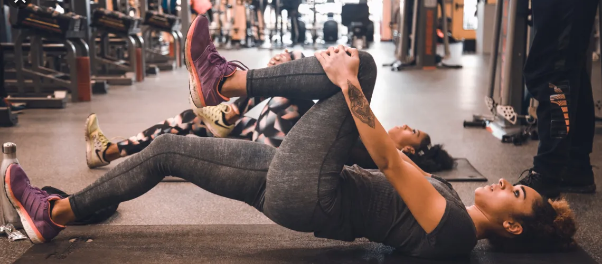*This page may contain affiliate links. When you buy through these links, we may earn a small commission at no extra cost to you.
With so many different brands of sneakers on the market, it can be difficult to choose which one is best for your exercise needs.
This is often because they may look similar in design but have different functions depending on how they are used.
This is why it is not surprising to see people confuse running shoes with cross-training shoes.
While both shoes are meant for exercise and can be used for walking or running, they have a different functions in terms of how they are constructed, the materials that are used, and how they are supposed to be employed.
Understanding what cross-training shoes are, how they are supposed to be used, and how they differ from running shoes will help you make the best-informed decision about whether they are right for your needs or not.

What are Cross Training Shoes?
A cross-training shoe is what the name implies, a shoe that is designed for several different activities to be performed.
The most common type of cross-training shoe offers a greater cushion in the heels for running as well as more stability for lateral movement (such as needed when playing tennis).
They also have more cushions in the front of the shoe for activities that require jumping or being more on the toes, such as volleyball.
The term cross training comes from a popular form of exercise that combines different activities to keep the muscles “guessing” and stimulate new growth.
In other words, the muscles will not tone or grow as fast if the same activities are performed daily.
So, the cross-training shoe is designed to allow you to participate in different activities without having to purchase different types of shoes.
As such, there are several advantages to purchasing cross-training shoes for your exercise activities. The main advantages of this type of shoe include the following;
✅ Flexible:
Cross-training shoes are designed to be flexible in different directions because they are for activities that cause you to move in different directions.Thanks to this flexibility, your feet can stay comfortable in a good pair of cross-trainers while doing several different activities.
✅ Durable:
A good cross-training shoe is tough, durable, and will last a long time with proper use.
While it is still subject to the erosive effects of the elements, the stress of moving in different directions, and how well you take care of the shoe, they are generally speaking more durable compared to running shoes.
✅ Cost-Effective:
While a good pair of cross-training shoes may be somewhat more expensive compared to a good pair of running shoes, they allow you to do different activities without having to pay for different pairs of specialty shoes.
This saves you money in the long run as one pair does the job of several.
Overall, cross-training shoes are quite popular and offer many benefits. But can they do the job as well as running shoes when it comes to running, walking, or jogging?
Let’s have a look…
Running vs. Cross Training Shoes: Differences
There are notable differences between cross-training shoes and running shoes.
✅ Versatility:
The most notable difference is that running shoes are designed for one specific function, jogging and running.
While cross-training shoes are designed to handle a wide variety of activities that goes well beyond jogging and running.
✅ Weight:
The next most obvious difference is the weight. Cross-training shoes are considerably heavier compared to running shoes.
This is because running shoes are designed to be as light as possible, with cushioning only in certain areas.
Cross-training shoes are heavier because they have more material, more cushion, and more extensive stitching to handle the different stresses applied to the shoes.
✅ Cushion:
The weight of the cross-training shoes comes from the additional cushions, which are not required for running shoes.
This is an obvious visual difference between the shoes as you can see the thicker sole and greater cushioning inside the cross-training shoes.
Running shoes tend to be thinner with fewer cushions, save for those at the heel and front of the shoe.
✅ Durability:
Of course, durability is somewhat more questionable because it does depend on different factors.
How often you use the shoe and under what conditions matters considerably in how long they last.
However, cross-training shoes are designed to last longer because they undergo more stress compared to running shoes.
Their heavier design, along with stronger stitching, makes them a solid, durable shoe compared to the lighter running shoe.
Can You Use Cross Training Shoes for Running?
The answer is yes, but on a limited basis.
If you engage in running or jogging as part of your cross-training activities, they work well if you limit the time spent with the shoes.
In other words, the added weight of this type of shoe makes it less conducive to running compared to shoes that are designed specifically for jogging or running as the primary exercise activity.
So, if you are primarily a jogger or running and engage in a few other exercise activities, then you probably should not use cross training shoes.
You are far better off finding a good pair of running shoes that will help maximize your performance.
Can You Use Your Cross Training Shoes for Walking?
If walking is your primary form of exercise, then just like jogging or running, you should get a running shoe.
While walking is a different motion compared to running, the cushion points are generally the same, and the lightweight shoe is better suited for walking activities.
However, the toughness and durability of a cross-training shoe do offer advantages, especially if you are engaging in other types of exercise activities.
Mixing up your walking with resistance exercises, dancing, or activities that cause you to move in different directions, such as tennis or volleyball, means that the cross-training shoe is a perfect choice.
What can be said is that cross-training shoes are arguably better for walking compared to running, but the difference may not be great enough to choose this type of shoe over a running shoe.
Incoming search terms:- Are cross trainers good for walking
- why use cross trainer shoes
- are cross trainers good walking shoes






